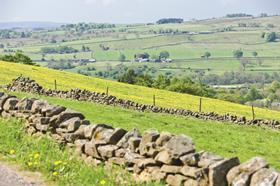Government adopts HS2 chairman Sir David HigginsŌĆÖ proposal for a trans-Pennine fast rail line

The government has thrown its weight behind a plan for a new fast rail line between Leeds and Manchester, dubbed a Crossrail for the North, which could slash journey times between the two cities and boost the northern economy.
Both the prime minister and the chancellor travelled to Leeds this week to back a report by HS2 chairman Sir David Higgins, which took forward plans for the second phase of HS2 (see story below), but also proposed a new fast rail line connecting Leeds and Manchester as part of a wider effort to improve connectivity and slash journey times across the north of England.
HigginsŌĆÖ report said that based on preliminary work undertaken by Network Rail, the options for improving east-west connectivity in northern England ranged from a ŌĆ£new dedicated, high-speed track involving the construction of a tunnel underneath the Pennines to an upgrade of the existing line using existing but unused tunnelsŌĆØ.
He said a ŌĆ£much improvedŌĆØ service was possible, cutting the journey time from Leeds to Manchester from around 55 minutes to between 26 and 34 minutes, depending on what option is chosen, comparable to the journey time from Heathrow to Canary Wharf on LondonŌĆÖs under-construction Crossrail line.
ŌĆ£Clearly that is transformation and would, undoubtedly, lead to more trade and commuting between the two cities,ŌĆØ HigginsŌĆÖ report said.
Although the report did not put a cost on the proposals, David Cameron said the new fast rail line could cost as much as ┬Ż7bn.
Speaking alongside the prime minster, George Osborne said the proposal was ŌĆ£affordableŌĆØ and the government was ŌĆ£giving the green lightŌĆØ to the development of the plan.
Osborne admitted that the original plan for HS2 had a ŌĆ£big flawŌĆØ in that it was ŌĆ£all about linking the North and South and we had missed east-west connectionsŌĆØ.
The report added that journey times from Leeds to Liverpool could be cut from around two hours to an hour, with half an hour cut from the journey from Manchester to Hull and Newcastle.
Higgins said more extensive work would now be undertaken to determine the cost and value for money for each route between Leeds and Manchester, with a full report to be published in March.
It is understood that the government is considering a completion date of 2027, depending on what option is taken.
HigginsŌĆÖ report added that improving the connectivity between Leeds and Manchester must be a ŌĆ£first step in what should be a clear strategy to address poor connectivity across the North from Liverpool to Hull, as well as to Sheffield and NewcastleŌĆØ.
Higgins also called for the creation of a new body, called Transport for the North, based broadly along the lines of Transport for London, to represent the city regions of
Liverpool, Manchester, Leeds, Sheffield and Newcastle, to develop an integrated strategic transport plan for the North.
HS2 phase 2
Sir David HigginsŌĆÖ report confirmed plans for a Y-shaped extension of HS2 beyond Birmingham to Manchester and Leeds, and set out several other key recommendations, including:
- The North-west ŌĆ£superhubŌĆØ should be at Crewe and should be completed by 2027, six years earlier than currently planned
- That the route to Manchester should go via a new station at Manchester airport, but more work needs to be carried out on the approach to Manchester
- On the eastern branch, Higgins called for a fundamental review to determine the ŌĆ£best solutionŌĆØ for the station in Leeds, given plans for a new east-west rail line (see story left) and the growth in rail use in the city
- That more work be carried out on the location of the East Midlands hub at Toton, which Higgins said could be located further west to provide better rail and road connections via the M1 and the Midland Main Line
- That the South Yorkshire hub should remain at Sheffield Meadowhall, outside of Sheffield city centre, despite efforts by Sheffield council to have the station moved to the disused Sheffield Victoria station site in the city centre.



























No comments yet